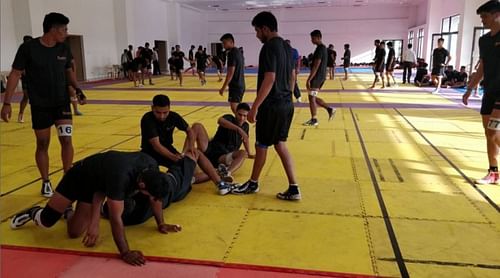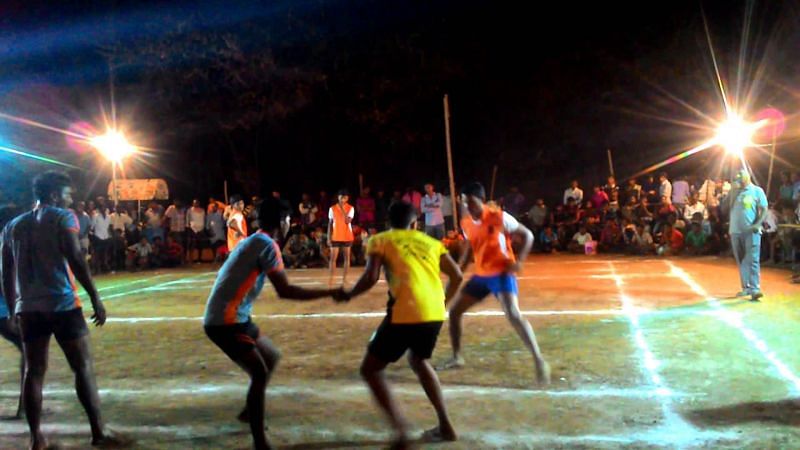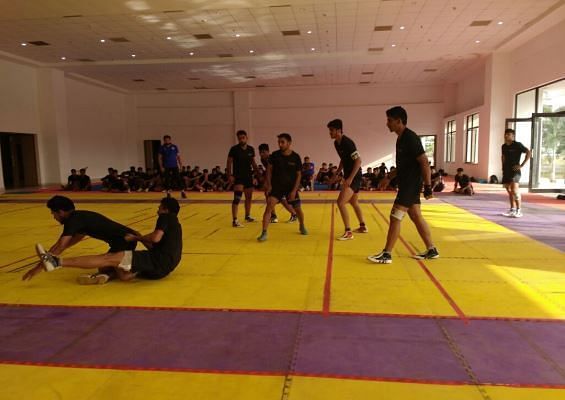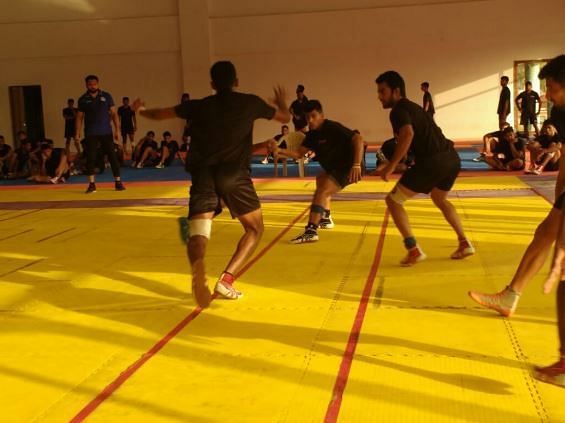
Pro Kabaddi League 2018 Season 6: Future stars risk it all for ticket to the big league

Far away from the madding crowd of the Maximum City, some of India's best young kabaddi players have been slugging it out at the Ramsheth Thakur Sports Complex in the Panvel Taluka as they look to impress the Pro Kabaddi League franchises.
Over 3,000 kids (between the age of 18 to 22) were hand-picked from across 18 different cities, and gradually, the number has now been narrowed down to 87. These 87 players, who were a part of the Future Kabaddi Heroes (FKH) programme, are now set to go into the drafts from where they would be picked up by the different franchises.
Jaivir Sharma, a Sports Authority of India (SAI) coach, who is currently training the FKH players, believes that a few of the current youngsters even have the potential to exceed some of the top stars in Pro Kabaddi League.
"People talk about the next Sachin (Tanwar) coming out of the FKH. But that is not what I am looking for. I am looking for someone who could even eclipse the likes of Pardeep Narwal," Jaivir said to Sportskeeda.
"There's no doubt that Pardeep has been one of the best players in the last couple of seasons. So my aim is to bring out a player who can either score more points than him, or a player who can successfully tackle someone like Pardeep everytime he goes raiding," he added.
High hopes fuelled by top facilities

Most of these players come from rather humble backgrounds, and have never been exposed to such high levels of training. So far, they have completed three weeks of their month-long camp in Navi Mumbai.
During these three weeks, the players have had to go through a rigorous training regime -- two hours of fitness training in the morning, two hours of skill training in the afternoon, and another three-four hours of practice matches in the evening.
"I can feel that my stamina has increased quite a lot. There's been an improvement in my core strength as well. We are learning a lot in the skills training as well," said 20-year-old defender Anil Narwal.
The programme has also brought the players under a centralised diet system that makes sure that they receive the right kind of nutrition without interfering with their individual food choices.
"There's a lot of emphasis on fitness and diet here. Our diet is strictly planned. We get things like fruits, juices, milk for breakfast in the morning," said Anil. "But again, your choice of food is completely your own. Chicken is an essential part of the diet for many. But there's no compulsion to eat chicken if you're a vegetarian."
Despite such high levels of fitness training and a strictly planned diet, many of the players require education about how to optimise their bodies, and this is an area where the physios come in.
"These players have certainly gotten much fitter after coming to this camp. But the point is not just about their fitness," said Manas Thakur, a physio at the camp. "Most of them come from pretty humble backgrounds. So they do not know much about how to keep themselves on the top of their fitness. They're not aware of most of the modern techniques."
However, India being the diverse country that it is, the trainers and physios often face issues while communicating with the players.
"It is quite difficult to make them understand what we want from them. Some of them are from South India, and they neither speak Hindi, nor English properly," said Thakur. "So the only way of communicating with them is through gestures and certain words like 'pain, little pain, more pain'."
Injuries are a part and parcel of any sport, and kabaddi being a contact sport, brings in all the more risk for the players. Some of these players have already carried injuries into the camp, while others have picked up niggles here and there during the programme. The likes of Thakur and his fellow physios have a rehab programme in place for the injured players who require it.
"We start with their rehab and do whatever we can by protecting the structures. So we could get them into a rehab programme, or we could advise them rest for two-three days," said Thakur. "You cannot fast track the recovery time for each of the players. But what can be done is that we can at least strengthen the muscle that has been injured."
From 'mitti' to the mat

With most of the young players coming from far-off villages, it is evident that they have not been exposed to facilities like the ones they are currently getting at the Ramsheth Thakur Sports Complex.
From getting ice-bath recovery sessions to strictly-planned diets, to even something as simple as getting proper treatment for the niggles that they pick up -- it is all new for them. However, there is one aspect of these top facilities that many believe may put the players at a greater risk.
Manpreet Singh, who coached Gujarat Fortunegiants to the Pro Kabaddi League final last season, was also one of the coaches who were training the kids. He is often seen pushing the players to go the extra mile during the practice matches, when the scouts and representatives of different franchises are present to gauge out the players.
However, even Manpreet was seen asking the players to not push too hard: "Zyada hard mat khel. Agar pair unnatural position pe gira, toh aur push mat kar. (Don't push too hard if you feel that your foot landed in an unnatural position)."
One of the biggest fears for the young kabaddi players is making the switch from playing on "mitti" or clay surfaces back in their villages, to the mats that are used in professional level kabaddi.
"These guys are also getting used to this. Their muscle strength has also been improving bit by bit. But the chances of getting major injuries are still higher on a mat, from a technical point of view," said physio Thakur.
"There is quite a lot of difference while playing on clay, or playing on a mat. You can just slide on clay, and you won't get injuries. You'll only get bruises that will heal within five to 10 days," he continued. "But on a mat, if you try a similar sliding movement, there's a slightly higher chance that your leg will lock, and you may end up getting a fracture or a ligament injury."

Left cover Anil Narwal, who hails from a small village called Rindhana in Haryana, has been playing on clay pitches since he was a child. However, he admits that internal injuries could turn out to be a problem on the mats.
"I've grown up playing on clay pitches. The risk of injuries on those pitches are far lesser than on mats," said Narwal, while Thakur swiftly adjusted the position of his leg. "Sometimes you get a weird feeling on your leg after training on mats. But then our physio knows how to deal with these things."
However, like most athletes, he waved off the knock he received during one of the practice sessions when asked about it.
Ajay Paswan, 19, who came out as one of the most promising raiders during one such practice session, is an embodiment of injuries. While he prides himself on his ability to get out of tight situations while raiding, one look at his feet reveals a different story.
Filled with cuts and bruises, it is pretty clear that Ajay is a player who does not shy away from being physical when required. Nevertheless, even he is of the opinion that clay pitches are safer to play on than mats. "The injuries on clay courts are not that severe. They heal in a few days," he said.
"But you can actually risk getting severe injuries on a mat. God forbid, I have not had to face such injuries as of yet, but I have been told that you can get a lot of internal injuries on mats, and these can take a lot of time to heal," he added.

However, it is not a black and white picture, when it comes to playing on the mats. One particular aspect of the mats makes it attractive to the players, especially the raiders.
"You can get a lot of speed on a mat. You can make swift movements, change directions. But on clay, these aspects are a bit slower," Ajay opined.
"I don't know much about how injuries work, but as a raider, I can generate a lot of speed on the mat, as compared to clay or on the beach. That obviously gives me a lot of advantage," said Shiv Ganesh Reddy, another 19-year-old from Andhra Pradesh. "I think you just need to keep yourself fit. If you maintain proper fitness, then injuries would not be an issue."
Professional Kabaddi, these days are all played on mats, while clay pitches are only used on the local level or in circular kabaddi. Most professional kabaddi players have made a successful switch from the clay to the mat, and that is something that these youngsters would also have to adapt to. Hence, a stepping stone like this could certainly go a long way in preparing them for the big league.